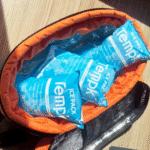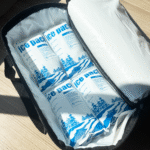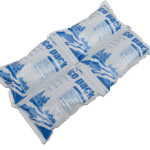في 2025, maintaining the integrity of temperature-sensitive shipments is crucial for the success of cold chain logistics. Shipping container dry ice pack sheets have become an essential tool in achieving this, particularly for industries handling pharmaceuticals, الأطعمة القابلة للتلف, والعينات البيولوجية. These sheets provide an efficient, cost-effective solution for maintaining required low temperatures, ضمان الامتثال للوائح, and protecting valuable goods from spoilage during long-distance transport.
-
What makes shipping container dry ice pack sheets indispensable for cold chain logistics?
-
How do dry ice pack sheets work to keep goods frozen during transit?
-
What are the latest trends in cold chain logistics and dry ice shipping in 2025?
What Makes a Shipping Container Dry Ice Pack Sheet Essential in 2025?
Shipping container dry ice pack sheets offer an essential advantage over traditional dry ice methods, combining the ultracold cooling power of dry ice with the flexibility and space-saving design of foldable sheets. These sheets absorb water, تجميد, and then provide cooling for up to 72 ساعات, depending on the size of the shipment and environmental conditions. Unlike dry ice blocks, which sublimate quickly, dry ice pack sheets are designed to reduce sublimation loss to 3-8% يوميا, ensuring more efficient use of dry ice and minimizing costs. They are especially valuable in industries where temperature maintenance is critical, مثل الأدوية, اللقاحات, والأطعمة المجمدة.
How Do Dry Ice Pack Sheets Work in Shipping Containers?
Dry ice pack sheets function by absorbing water, freezing into ice pockets, and slowly releasing cold over time. عند تفعيلها, these sheets are placed in a well-insulated shipping container, where they ensure that temperature-sensitive goods remain frozen during transit. كما يسامي الثلج الجاف (يتحول من الصلب إلى الغاز), it gradually cools the surroundings without leaving any liquid residue, which prevents potential contamination of the products.
These sheets are designed for flexibility, fitting snugly around different-sized containers and product types, offering a versatile cooling solution that traditional dry ice blocks cannot match. Their reusable nature also contributes to a more sustainable shipping practice by reducing waste.
What Are the Benefits of Using Dry Ice Pack Sheets?
-
تحسن في درجة الحرارة: Dry ice pack sheets maintain consistent low temperatures, significantly reducing the risk of temperature excursions during shipping.
-
فعالة من حيث التكلفة: By reducing the need for single-use refrigerants, these sheets lower overall shipping costs. They also help minimize spoilage, making them a more economical choice in the long run.
-
صديقة للبيئة: With their reusable design, dry ice pack sheets contribute to sustainability goals by reducing packaging waste and the need for disposable ice packs.
-
Flexible and Customizable: These sheets are available in various sizes and thicknesses, tailored to fit the specific needs of each shipment, enhancing both cooling efficiency and cost-effectiveness.
Key Considerations for Using Dry Ice Pack Sheets Effectively
عند الشحن مع الجليد الجاف, several factors determine the effectiveness of your cooling solution. Here’s what you need to consider:
ما مقدار الجليد الجاف الذي تحتاجه?
The amount of dry ice required depends on:
-
The temperature sensitivity of the goods.
-
The size of the shipment.
-
The duration of the transit.
-
The ambient temperature outside the shipping container.
A general rule of thumb is to use about 1–2 lbs of dry ice for every 10 lbs of shipment weight per 24 ساعات الشحن. For high-value or highly sensitive goods, more dry ice may be necessary to ensure temperature control throughout the journey.
How to Pack Dry Ice in Shipping Containers?
Packing dry ice efficiently involves the following steps:
-
Layer the bottom of the container with dry ice sheets to create a cooling base.
-
استخدم التغليف المعزول to protect the goods from direct contact with dry ice.
-
ضمان التهوية for the CO₂ gas to escape safely, as trapped CO₂ could cause pressure buildup and rupture the container.
Best Practices for Safe Handling of Dry Ice
Dry ice is effective but requires careful handling. Follow these safety practices:
-
تهوية: Always ensure the shipping container is well-ventilated to allow the CO₂ gas to escape safely.
-
وضع العلامات الصحيحة: All containers should be clearly labeled with the “ثاني أكسيد الكربون, صلب” ملصق, as required by both DOT and IATA regulations.
-
معدات الحماية الشخصية (PPE): Always wear insulated gloves and safety goggles when handling dry ice to prevent frostbite and other injuries from extreme cold temperatures.
2025 Trends in Dry Ice Shipping and Cold Chain Logistics
تتطور صناعة لوجستيات السلسلة الباردة بسرعة, and dry ice shipping solutions are being influenced by several key trends:
Advances in Smart Packaging
The integration of IoT sensors with dry ice pack sheets is one of the most significant developments in the industry. These smart solutions enable real-time monitoring of temperature, رطوبة, and CO₂ levels, ensuring that goods remain within their required temperature ranges throughout the transit period.
الاستدامة والتغليف الصديق للبيئة
As sustainability becomes more important, dry ice solutions are evolving to be more eco-friendly. This includes reducing CO₂ emissions and adopting biodegradable packaging and renewable energy sources for dry ice production.
Regulatory Compliance and Automation
The logistics industry is seeing stricter regulations, particularly in the transportation of pharmaceuticals and biologics. The need for enhanced safety features, such as pressure-tested packaging and real-time tracking, is driving innovations in both dry ice packaging and logistics management. Automation is also being embraced to improve operational efficiency and reduce errors in the packaging and shipping process.
الأسئلة المتداولة
س 1: كيف أحسب كمية الثلج الجاف اللازمة لشحنتي؟?
لحساب متطلبات الثلج الجاف, consider factors like the size of the shipment, مدة العبور, and the temperature sensitivity of the goods. عمومًا, لكل 10 lbs of shipment, use 1–2 lbs of dry ice per 24 ساعات العبور.
Q2: Can dry ice damage my products during shipment?
If not packed correctly, dry ice can cause product damage. لتجنب هذا, ensure that proper insulation is used between the dry ice and the products being shipped.
س 3: Is dry ice regulated for air transport?
نعم, dry ice is regulated by IATA for air transport. وضع العلامات المناسبة, تهوية, and packaging are required to ensure safety during transit.
الخلاصة والتوصيات
ختاماً, dry ice pack sheets are an essential tool in modern cold chain logistics, especially as businesses navigate the complex demands of 2025’s shipping standards. By incorporating dry ice pack sheets into your shipping process, you ensure the safe, فعالة من حيث التكلفة, والنقل الصديق للبيئة للسلع الحساسة للحرارة. للبقاء قادرة على المنافسة, businesses should:
-
Assess shipping requirements and calculate dry ice needs accurately.
-
استثمر في التغليف الذكي and temperature monitoring to enhance shipping reliability.
-
ضمان الامتثال with industry regulations, وخاصة بالنسبة للشحنات الجوية.
حول Tempk
في Tempk, we specialize in providing advanced cold chain solutions tailored to your industry’s needs. صفائح حزمة الثلج الجاف لدينا, along with other innovative packaging solutions, ensure the safe transport of temperature-sensitive goods, من الأدوية إلى الأطعمة القابلة للتلف. We are committed to sustainability and compliance, providing solutions that reduce waste and carbon footprints.
على استعداد لتحسين لوجستيات سلسلة التبريد الخاصة بك? Contact Tempk for personalized consultation or to request a free sample of our dry ice pack sheets.
























